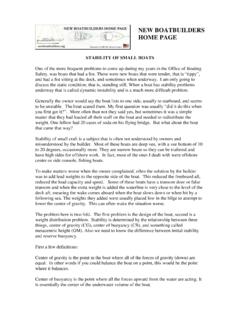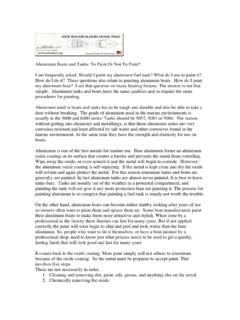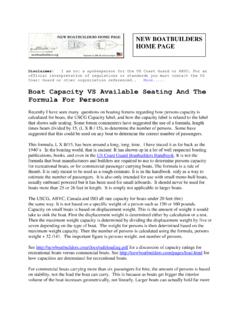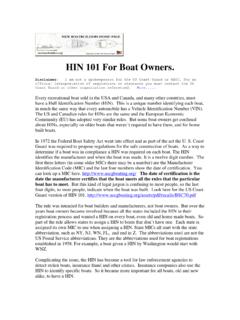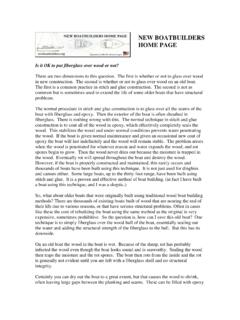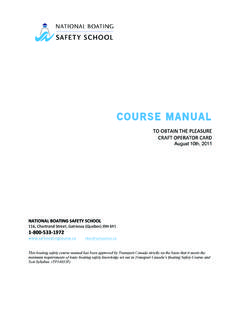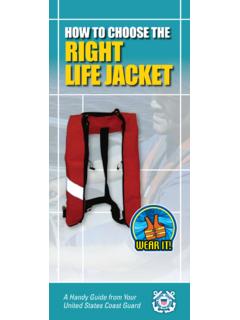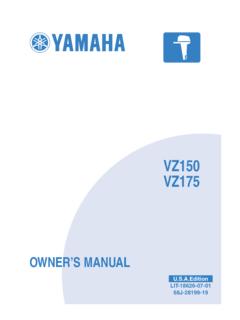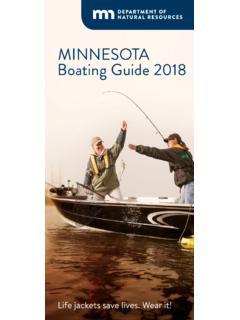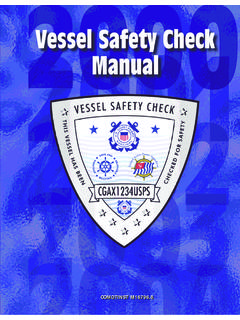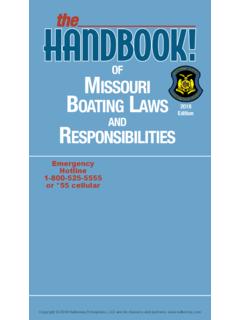Transcription of SAFETY STANDARDS FOR BACKYARD BOAT BUILDERS
1 Department of Transportation United States Coast Guard SAFETY . STANDARDS . FOR. BACKYARD . boat BUILDERS . COMDTPUB Department Commandant Washington, DC 20593-0001. Of Transportation United States Coast Guard Staff Symbol: (G-NAB-6). Phone (2021) 267-0981. United States Coast Guard FOREWORD. This pamphlet, SAFETY STANDARDS FOR BACKYARD boat BUILDERS , . (COMTDPUB ), is a simplified explanation of Federal recreational boat construction requirements and is intended for the use of the non-professional, individual builder. The primary objective of these requirements is to avoid certain SAFETY hazards which have been found to be the cause of boating accidents.
2 This pamphlet is routinely sent to new manufacturers of recreational boats for the purposes of sale, because it gives a good explanation of how to go about complying with certain portions of the Federal SAFETY STANDARDS and regulations. However, boat manufacturers are reminded that this pamphlet should not be used as a substitute reference for the applicable portions of the Code of Federal Regulations with which they are ultimately responsible for compliance. The STANDARDS and regulations explained in this pamphlet were issued under the provisions of Chapter II of Title 46 of the United States Code and appear in Subchapter S (Boating SAFETY ) of Chapter 1, Title 33 (Coast Guard, Department of Transportation) of the Code of Federal Regulations.
3 The previous edition of this pamphlet, COMDTPUB , dated August 24, 1988 is cancelled. W. J. Ecker Rear Admiral, Coast Guard Chief, Office of Navigation SAFETY and Waterway Services 2. CONTENTS. SAFE POWERING 2. SAFE LOADING 6. BASIC FLOTATION 16. LEVEL FLOTATION 16. LOCATION OF FLOTATION MATERIAL 26. LEVEL FLOTATION RETROFIT 29. VENTILATION 30. GASOLINE FUEL SYSTEMS 34. ELECTRICAL SYSTEMS 35. CAPACITY LABEL 36. HULL IDENTIFICATION NUMBER 37. CERTIFICATION LABEL 38. FLOTATION MATERIALS 39. SURVIVAL HANDLES 43. STATE ISSUING AUTHORITIES 46.
4 COAST GUARD DISTRICTS 50. NOTE. READ THIS ENTIRE PAMPHLET BEFORE YOU BEGIN ANY OF THE. CALCULATIONS IN A PARTICULAR SECTION. 2. Boating accidents cause property damage, often result in injuries and may even result in deaths. The best way to avoid a serious boating accident is to know safe boating practices, use sound judgement while boating and build SAFETY features into your boat . This will not only reduce your chances of ever having a boating accident, but also give you a better chance of surviving if you do have one.
5 The Coast Guard has published this pamphlet to explain Coast Guard required SAFETY STANDARDS to people who intend to build their own boats. The Coast Guard SAFETY STANDARDS and the boats to which they apply are outlined below: Less than Greater than or Equal to 20. 20 feet in length feet in length Rowboats O/B I/B & I/O O/B I/B & O/B. SAFE LOADING X X X. SAFE POWERING X. FLOTATION X X X. FUEL (GAS) X X. ELECTRICAL (GAS) X X. VENTILATION X* X X* X. CAPACITY LABEL X X X. CERTIFICATION LABEL X X X X* X. HIN ALL BOATS MUST BEAR TWO HULL IDENTIFICATION NUMBERS.
6 NOTE. SAILBOATS WITH GASOLINE POWERED INBOARD AUXILIARY ENGINES AND. ALL BOATS WITH PERMANENTLY INSTALLED GASOLINE GENERATORS MUST. MEET THE REQUIREMENTS FOR FUEL SYSTEMS, ELECTRICAL SYSTEMS, VENTILATION SYSTEMS AND A CERTIFCATION LABEL. ANY boat WITH A COMPARTMENT CONTAINING A GASOLINE FUEL TANK. MUST MEET THE REQUIREMENTS FOR VENTILATION. SAILBOATS (EXCEPT INBOARD AUXILIARIES), CANOES, KAYAKS, INFLATABLES, SUBMERSIBLES, RACEBOATS, SURFACE EFFECT VESSELS. AND AMPHIBIOUS VEHICLES ARE EXCEPTED FROM ALL REQUIREMENTS. EXCEPT FOR THE HULL IDENTIFICATION NUMBERS.
7 SUMMER 1993. This pamphlet shows how to calculate your boat 's safe horsepower capacity (if it will be powered by an outboard) and its safe load capacity (both in pounds and the numbers of people). This pamphlet also explains how to determine how much flotation material you need to keep your boat afloat if it is swamped, and where to install the flotation. Also, if your boat will carry a gasoline powered inboard or inboard/outdrive engine, we'll explain the Electrical System, Fuel System and Ventilation System regulations and tell you how to get additional information which describes the requirements in greater detail.
8 Also included in Appendix D is a design guideline for installing survival handles which are recommended for boats equipped with basic flotation. To help you through the calculations covering Safe Powering and Safe Loading presented in this pamphlet, we have included on page 11 completely worked out examples for a foot outboard runabout equipped with remote steering and a foot dinghy with manual steering. Those of you who are building inboards and inboard/outdrives will have steps in addition to and different from those given in the example, but they should give you no trouble.
9 SAFE POWERING. HOW MUCH HORSEPOWER CAN YOU SAFELY PLACE ON YOUR OUTBAORD. POWERED boat ? (There is no limitation on the horsepower of inboards and inboard-outdrives.). First measure the length of your boat and the width of its transom. Then you multiply these numbers to get a third number, called a factor. You then use this factor to find your safe horsepower capacity. Keep your measurements in feet and hundredths of a foot. Here are some inches and their approximate hundredths to help you: Inches Hundredths 1 = 2 = 3 = 4 = 5 = 6 = 7 = 8 = 9 = 10 = 11 = 12 = So for a boat 19 feet, 7 inches long, your measurement would read feet.
10 2. boat LENGTH. LENGTH LENGTH. LENGTH LENGTH. TRANSOM WIDTH. CONVENTIONAL CONVENTIONAL FLAT BOTTOM CONVENTIONAL HARD CHINE WITH. SOFT CHINE HARD CHINE HARD CHINE ROUND BILGE TUMBLEHOME. Spray rails can be included in your measurement of transom width if the rails act as part of the planing surface. 1. Measure boat length: boat length in feet is 2. Measure width of transom: Transom width in feet is 3. Now multiply length times width to get your factor (that is, your answer). 4. Round off your factor to the nearest whole number.
